Airborne Command Posts
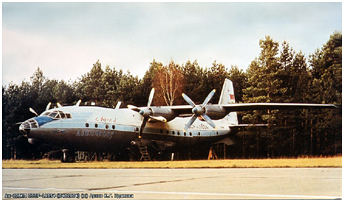
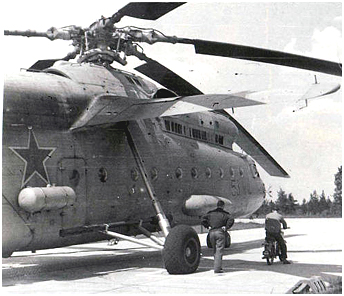 Le Mi-6VKP n°53 du 113.OSAE à Sperenberg. On notera le mât d'antenne destiné aux opération au sol, attaché au train
d'atterrissage. © N.Balan.
Le Mi-6VKP n°53 du 113.OSAE à Sperenberg. On notera le mât d'antenne destiné aux opération au sol, attaché au train
d'atterrissage. © N.Balan.
The Mi-6 VKP n°53 at Sperenberg. Note the antenna mast for ground operations attached to the
landing gear. © N.Balan.
There were more than transport aircraft - including special variants like the An-26RTR - and transport helicopters at Sperenberg.
Airborne command posts also were on strength with the 113.OSAE (Separate Composite Aviation Squadron). According to the testimony of a former Mi-8 pilot
assigned to that unit between 1978 and 1982, the main mission of the 113.OSAE was to provide direct support to the GSFG Commander-in-Chief.
The squadron's helicopter fleet included one Mi-6VKP "Hook-B" and two Mi-22 "Hook-C" (see > The Mi-6 and Mi-10) at the end of the seventies.
Moreover, Mi-9 "Hip-G" command posts were also observed at Sperenberg and their assignment to the 113.OSAE could not be more logical.
In addition, that unit also flew an aircraft modified into an airborne command post.
A former crew member of Mi-6VKP n°53 mentioned the presence of an Antonov An-10 "Cat" command post at Sperenberg during its assignment to the 113.OSAE between 1978 and 1984.
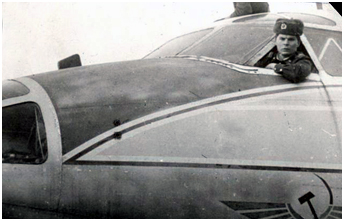 L'An-10VKP vu à Sperenberg au début des années 80. © Y.Verigin.
L'An-10VKP vu à Sperenberg au début des années 80. © Y.Verigin.
The An-10VKP seen at Sperenberg during the early 1980s © Y.Verigin.
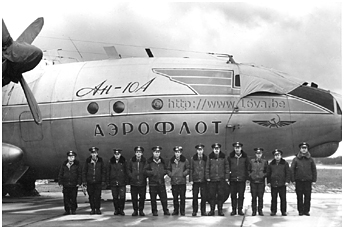 It would be in 1970, at the initiative of General V.F. Margelov, Commander or the Airborne Troops,
(Vozdushno-Desantnyye Voyska, VDV) that an An-10AS or TS (?) airframe was converted into an airborne command post.
We can find the traces of at least five An-10VKP, including one based at Sperenberg.
That An-10 version was designated An-10KP or VKP, according to different sources. Whatever, KP or VKP mean almost the same:
(Vozdushnyy) Kommandnyy Punkt or (Airborne) Command Post. The aircraft based at Sperenberg (SSSR-11854 s/n 0401904) was disguised in full Aeroflot
markings, like all the An-10VKP. However, additional antennas located on the fuselage betrayed the real purpose of this aircraft.
A dozen operators managed telecommunication systems and space was provided for staff officers.
The An-10VKP could perform its mission both in flight and on the ground (picture showing an An-10VKP during ground operations > Here).
SSSR-11854 was retired during the 1980s. The plan was to put it on display at the GSFG Headquarters located at Zossen-Wünsdorf.
Unfortunately, this project did not go through and the An-10 ended its day as a target simulating a parked USAF AWACS aircraft on the Wittstock firing range.
Its remnants were retrieved in 1993 and transferred to Rangsdorf to be scrapped.
It would be in 1970, at the initiative of General V.F. Margelov, Commander or the Airborne Troops,
(Vozdushno-Desantnyye Voyska, VDV) that an An-10AS or TS (?) airframe was converted into an airborne command post.
We can find the traces of at least five An-10VKP, including one based at Sperenberg.
That An-10 version was designated An-10KP or VKP, according to different sources. Whatever, KP or VKP mean almost the same:
(Vozdushnyy) Kommandnyy Punkt or (Airborne) Command Post. The aircraft based at Sperenberg (SSSR-11854 s/n 0401904) was disguised in full Aeroflot
markings, like all the An-10VKP. However, additional antennas located on the fuselage betrayed the real purpose of this aircraft.
A dozen operators managed telecommunication systems and space was provided for staff officers.
The An-10VKP could perform its mission both in flight and on the ground (picture showing an An-10VKP during ground operations > Here).
SSSR-11854 was retired during the 1980s. The plan was to put it on display at the GSFG Headquarters located at Zossen-Wünsdorf.
Unfortunately, this project did not go through and the An-10 ended its day as a target simulating a parked USAF AWACS aircraft on the Wittstock firing range.
Its remnants were retrieved in 1993 and transferred to Rangsdorf to be scrapped.
But the career of the An-10VKP from Sperenberg raises many unanswered questions. On May 18, 1972, An-10A SSSR-11215 disintegrated during the descent on the landing approach into
Kharkiv in Ukraine, killing 122 people. The accident investigation revealed cracks in the wing brackets as well as abnormal wear of the stiffeners of their central section.
Similar failures also were found on many aircraft and, consequently, Aeroflot ceased An-10 exploitation as early as 1973. However, some aircraft continued to fly with military
and paramilitary organizations. Rare testimonies mention that some An-10VKP were not withdrawn from service until the mid-1980s. SSSR-11947 assigned to the Airborne Forces made
its final flight on March 25, 1980. The operational life of the Sperenberg-based aircraft thus remains a mystery. Did it continue to fly regularly or occasionally, or was it simply kept
in reserve?
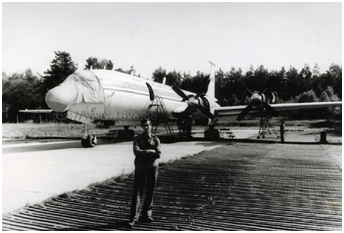
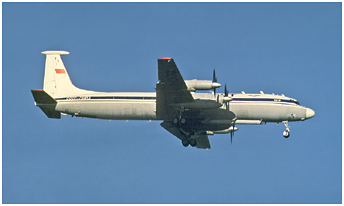 The An-10VKP successor was an Il-22M-11 "Zebra" or "Coot-B" for NATO. The Il-22 was based on the civilian Il-18D. It was developed by the Myasishchev Experimental
Machinery Plant (MMZ n°30) at Zhukovskiy, from 1970 on. The Il-18 airframe already had proved its adaptability especially with the SIGINT Il-20 "Coot-A," of which
two modified Il-20M platforms were also based at Sperenberg with the 39.ORAO (see > 3.4 Reconnaissance and Electronic Warfare).
The Il-18D-36 "Bizon" (designated Il-22 in service) or Article 36, were new airframes adapted by Myasishchev. Besides numerous antennas located on the fuselage, that aircraft
type could be easily identified thanks to the fairing located on top of the fin. Also, another characteristic was the long semi-cylindrical ventral fairing running almost
the full length of the fuselage.
The An-10VKP successor was an Il-22M-11 "Zebra" or "Coot-B" for NATO. The Il-22 was based on the civilian Il-18D. It was developed by the Myasishchev Experimental
Machinery Plant (MMZ n°30) at Zhukovskiy, from 1970 on. The Il-18 airframe already had proved its adaptability especially with the SIGINT Il-20 "Coot-A," of which
two modified Il-20M platforms were also based at Sperenberg with the 39.ORAO (see > 3.4 Reconnaissance and Electronic Warfare).
The Il-18D-36 "Bizon" (designated Il-22 in service) or Article 36, were new airframes adapted by Myasishchev. Besides numerous antennas located on the fuselage, that aircraft
type could be easily identified thanks to the fairing located on top of the fin. Also, another characteristic was the long semi-cylindrical ventral fairing running almost
the full length of the fuselage.
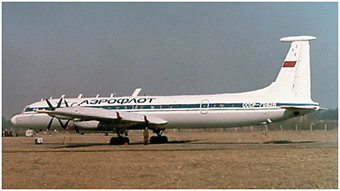
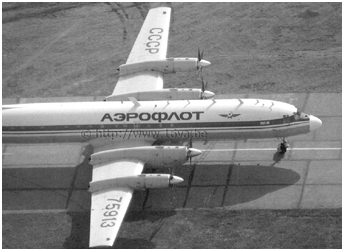 Article 40 was an improved variant developed in 1977 with the designation Il-22M-11 "Zebra."
On this model, the length of the ventral fairing was significantly reduced, the latter ending at the wing leading edge root.
Most of the Il-22M also were modified new airframes; however, a few Il-22 "Bizon" were upgraded to the Il-22M standards.
Moreover, as new Il-18D were no longer available, former Aeroflot aircraft with a good remaining potential were in turn
modified into Il-22M due to a continuing VVS requirement for more airborne command posts.
Like all the Il-22s, the "Coot-B" from Sperenberg was camouflaged according to the art of maskirovka: "Il-18" markings on the forward fuselage
like the airliners, Aeroflot color scheme, and civilian registration ("CCCP-75913" s/n 0394011098). It made its first flight in 1982 and apparently replaced
the An-10VKP the same year.
More "Coot-B" sometimes were observed in the GDR. They were visitor aircraft like "75926" illustrated at left. The latter was photographed discreetly during a stopover at
Oranienburg in 1987. This Il-22M of the 245.OSAE was based at Osla-Krzywa in Poland and was used by the Commander-in-Chief, Western Military Operations Theater
(Zapadnyy Teatr Voyennykh Deystviy). Aircraft "75913" from Sperenberg was available to General Burlakov, commander of the Western Group of Forces (WGF, formerly GSFG)
at the time of its withdrawal from Germany in 1991. The former WGF airborne command post was still operational with the 8.ADON at Chkalovskiy in 1999 and it was finally
retired from service a few years later (> Photo).
Article 40 was an improved variant developed in 1977 with the designation Il-22M-11 "Zebra."
On this model, the length of the ventral fairing was significantly reduced, the latter ending at the wing leading edge root.
Most of the Il-22M also were modified new airframes; however, a few Il-22 "Bizon" were upgraded to the Il-22M standards.
Moreover, as new Il-18D were no longer available, former Aeroflot aircraft with a good remaining potential were in turn
modified into Il-22M due to a continuing VVS requirement for more airborne command posts.
Like all the Il-22s, the "Coot-B" from Sperenberg was camouflaged according to the art of maskirovka: "Il-18" markings on the forward fuselage
like the airliners, Aeroflot color scheme, and civilian registration ("CCCP-75913" s/n 0394011098). It made its first flight in 1982 and apparently replaced
the An-10VKP the same year.
More "Coot-B" sometimes were observed in the GDR. They were visitor aircraft like "75926" illustrated at left. The latter was photographed discreetly during a stopover at
Oranienburg in 1987. This Il-22M of the 245.OSAE was based at Osla-Krzywa in Poland and was used by the Commander-in-Chief, Western Military Operations Theater
(Zapadnyy Teatr Voyennykh Deystviy). Aircraft "75913" from Sperenberg was available to General Burlakov, commander of the Western Group of Forces (WGF, formerly GSFG)
at the time of its withdrawal from Germany in 1991. The former WGF airborne command post was still operational with the 8.ADON at Chkalovskiy in 1999 and it was finally
retired from service a few years later (> Photo).
 |
Interior views of an Il-22 Bizon withdrawn from use > LINK -
has undergone a major overhaul, was modernized and put back into service in June 2013! |
| An-12VKP PAGE |
 |
The transport assets < Part 1 < Part 2 > Part 4 |
 |
Plan du site - Sitemap |  |
